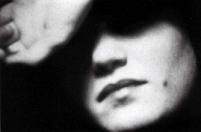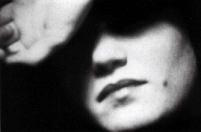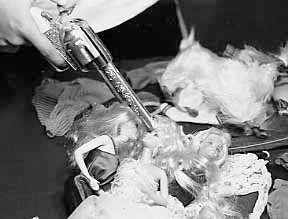Part of Winter 1990
D. Steve Sanguedolce 43 min, 1990
Films by Peggy Ahwesh & Josie Massarella
From Romance to Ritual P. Ahwesh, 21 min, 1985.
Martina’s Playhouse P. Ahwesh, 20 min, 1989.
No. 5 Reversal J. Massarella, 9 min, 1989.
This screening presents the premiere of local filmmaker Steve Sanguedolce’s Rhythms of the Heart, two ‘ethno-camp’ movies by American feminist Peggy Ahwesh, as well as the premiere of No. 5 Reversal by Josie Massarella.
“In Rhythms of the Heart, Steve Sanguedolce’s affinity for expressionistic documentaries turns to the depiction of a ruined relationship. Sanguedolce belongs to the Escarpment School: ‘ a loosely knit group of filmmakers born and raised along the craggy slopes of the Canadian shield. Their work typically conjoins memory and landscape in a documentary-based production. Inheritors of the 19th century Lake Poet romantics, ‘nature’ is typically figured as a metaphor for consciousness. Rhythms of the Heart typifies many of these Escarpment School concerns in its blend of personal narrative and landscape, redrafting its romantic heritage in a love story that deconstructs narrative traditions even as it tears its characters apart. Sanguedolce insistently replays loss through a metaphorical landscape while tirelessly focussing on the personally domestic. The film’s centre presents a myriad of visual enclosures such as sparsely lit studios, counter tops or framed bathrooms. The characters search throughout the film to find space within the maze of these settings which could allow them to live without the (Dionysian) dissolutions of sexual passion or the (Apollonian) dictates of the law”. (Excerpted from a review of Rhythms of the Heart by M. Hoolboom)
Peggy Ahwesh’s From Romance to Ritual and Martina’s Playhouse present a different kind of treatment for the theme of disfunctioning sexual identity and human interaction. Seemingly disparate terms like anthropological, kitsch, feminist and homemade have been used to describe the Super-8 work of Ahwesh. Her world is filled with odd objects and characters like eccentrics, transsexuals and Barbie dolls. Ahwesh interacts with and befriends her subjects and yet also shoots them with directorial distance as artifacts. The product is a unsettling tension between kitsch and pathos, the utopia of misfits and subcultures and the looming figure of daddy behind the movie camera.
No. 5 Reversal is an exploration of the capacity of the personal, subjective film to carry layers of meaning. The black and white photography entwines a stark lyricism of nature with the de- and reconstruction of civilization.


